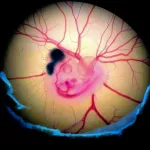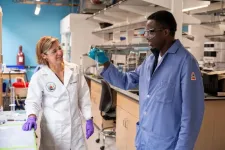(Press-News.org) The greater Los Angeles area has long been subject of intense seismographic monitoring. A network of highly sensitive seismometers peppers the region on a constant vigil for earthquakes. Now researchers at the Stanford Doerr School of Sustainability have developed a new way to use that existing infrastructure and its decades of data to estimate water levels in the region’s aquifers, which serve some 10 million residents of Los Angeles and Orange counties.
The researchers analyzed the impact of 2023’s historic series of atmospheric river storms, which dumped more than 140% of California’s 20th-century average annual precipitation in just three months. Those rains, combined with torrential rainfall in Southern California from Hurricane Hilary in August 2023, nearly refilled surface reservoirs and shallow aquifers depleted by decades of drought and groundwater extraction, the Feb. 14 study in Science shows.
But even a year of extreme precipitation failed to replenish aquifers located 50 meters or more below the surface. Unlike the shallow aquifers, these deeper aquifers regained only about 25% of the groundwater they had lost since 2006.
“Although 2023’s huge storms and Hurricane Hilary helped restore the surface reservoirs, we found that there is still substantial depletion in deep aquifers,” said lead study author Shujuan Mao, who completed most of the work as a George A. Thompson Postdoctoral Fellow in the Doerr School of Sustainability and is now an assistant professor at the University of Texas at Austin. “It appears that a single epic storm season is not enough to restore the groundwater depletion accumulated over the recent droughts. It will take many more wet years for the deep aquifers to fully recover,” she said.
New method
With guidance from Stanford geophysicists Gregory Beroza and William Ellsworth, Mao developed the approach and a new “Seismic Drought Index” for quantifying water deficits at different depths. The index values largely reinforce what water managers already know – recharging deep aquifers can take many years – but may provide a straightforward metric for lay audiences who might assume the heavy rains mean water supplies are fully restored.
Ellsworth described the new method as a “revolutionary” tool for measuring groundwater at high resolution using decades of seismic vibrations traditionally thought of as “noise” by the seismological community.
“We can use the ambient seismic vibrations and analyze the speed of seismic waves to sense the aquifers. These are vibrations that are going on in the earth all the time from all sorts of different sources,” including wind, traffic, and ocean waves, explained Ellsworth, a research professor emeritus of geophysics. Ellsworth was surprised to see how well the minute changes in seismic wave speeds can be measured to monitor groundwater levels. “The match is remarkable,” he said.
Traditionally, measuring groundwater levels has required drilling deep wells. A dedicated monitoring well can cost between $100,000 and $200,000 and can only measure in a single location, Mao explained. The new seismic method can measure entire basins at once, across different depths down to 800 meters (about half a mile), and over a period of decades.
“This new technology is potentially game-changing for groundwater management in that it moves us to a possible future where we can measure groundwater recharge – how much there is and where it’s going – much as we do with stream gauges for surface water,” said Beroza, the Wayne Loel Professor in Earth Science in the Doerr School of Sustainability.
To better understand its aquifer systems and support sustainable groundwater management, California has been mapping geology in key groundwater basins since 2021 down to about 1,000 feet using airborne geophysical instruments. But these surveys do not reveal past or present groundwater levels.
“We realized that there was a more affordable way to measure the groundwater dynamics. The seismic infrastructure is already in place and the data has been captured continually for decades,” Mao said. “It’s a buy-one-get-one-free technology.”
Water woes
Given the efficiency and the resolution of the new method, the authors hope that water managers use their new approach to assess ways to ensure more precipitation can be diverted to seep back into the underground reservoirs, which are estimated to be able to store as much as 17 times the volume of water as California’s major surface reservoirs.
Another open question is whether, after prolonged droughts and historic overuse, the porous aquifers have not collapsed to the point where they are unable to hold as much water as they once did. Ellsworth noted that land in the southern San Joaquin Valley has sunk tens of feet over a period of decades due to aquifer depletion.
“The loss of aquifer storage capacity can be irreversible,” Mao said. “We hope that our method can help water agencies to fill gaps in their monitoring data, refine hydrologic modeling, and inform decisions about water use and conservation.”
Additional co-authors include Yujie Zheng, an assistant professor of geophysics at the University of Texas at Dallas. Funding for this study was provided in part by the George A. Thompson Fellowship at Stanford University. END
Los Angeles groundwater remained depleted after 2023 deluge, study finds
Historic rains filled Greater Los Angeles reservoirs and shallow aquifers nearly to capacity in 2023. But drought conditions persisted in deeper aquifers, according to a new analysis of seismic data from California’s earthquake monitoring network
2025-02-13
ELSE PRESS RELEASES FROM THIS DATE:
Foraging seals enable scientists to measure fish abundance across the vast Pacific Ocean
2025-02-13
EMBARGOED until Thursday, Feb.13, 2025, at 2 P.M. U.S. Eastern Time
SANTA CRUZ, Calif. – Over the past 60 years, marine biologists at UC Santa Cruz have monitored the behavior of northern elephant seals that journey to nearby Año Nuevo Natural Reserve. With the seals gathering on the beach by the thousands to breed and molt, generations of researchers have been able to amass more than 350,000 observations on over 50,000 seals.
With the help of powerful technologies and the intrepidness to get close ...
Dessert stomach emerges in the brain
2025-02-13
To find the cause of the "dessert stomach", the researchers investigated the reaction of mice to sugar and found that completely satiated mice still ate desserts. Investigations of the brain showed that a group of nerve cells, the so-called POMC neurones, are responsible for this. These neurones become active as soon as the mice were given access to sugar which facilitated their appetite.
When mice are full and eat sugar, these nerve cells not only release signaling molecues that stimulate satiety, but also one of the body's own opiate: ß-endorphin. This acts on other nerve cells with opiate receptors and triggers a feeling of reward, ...
Fungus ‘hacks’ natural immune system causing neurodegeneration in fruit flies
2025-02-13
A fungal infection has been shown to trigger a fruit fly’s own immune system to destroy brain cells leading to signs of neurodegeneration, a new study has found.
The paper published in PLOS Biology today found that a fungus called Beauveria bassiana was able to make the fly’s innate immune system trigger a process that kills neurons and glia in the brain, leading to more than half of flies dying after seven days compared to half of control samples living for nearly 50 days.
In experiments conducted by a team of academics from the University of ...
A new view on 300 million years of brain evolution
2025-02-13
Leuven, 14 February 2025 – In a new study published in Science, a Belgian research team explores how genetic switches controlling gene activity define brain cell types across species. They trained deep learning models on human, mouse, and chicken brain data and found that while some cell types are highly conserved between birds and mammals after millions of years of evolution, others have evolved differently. The findings not only shed new light on brain evolution; they also provide powerful tools for studying how gene regulation shapes different cell types, across species or different disease states.
Our brain, and by extension ...
Birds have developed complex brains independently from mammals
2025-02-13
The pallium is the brain region where the neocortex forms in mammals, the part responsible for cognitive and complex functions that most distinguishes humans from other species. The pallium has traditionally been considered a comparable structure among mammals, birds, and reptiles, varying only in complexity levels. It was assumed that this region housed similar neuronal types, with equivalent circuits for sensory and cognitive processing. Previous studies had identified the presence of shared excitatory and inhibitory neurons, as well as general connectivity patterns suggesting a similar evolutionary path in these ...
Protected habitats aren’t enough to save endangered mammals, MSU researchers find
2025-02-13
Images
EAST LANSING, Mich. – Tropical forests are massive biodiversity storehouses. While these rich swathes of land constitute less than one-tenth of Earth’s surface, they harbor more than 60% of known species. Among them is a higher concentration of endangered species than anywhere else on Earth.
However, these regions are also under immense pressure, as tropical land is rapidly being transformed for industrial and agricultural purposes.
Worldwide, regional governments and international groups are establishing new protected areas to slow further loss of threatened species. However, new research appearing in the journal PLOS Biology demonstrates ...
Scientists find new biomarker that predicts cancer aggressiveness
2025-02-13
HOUSTON ― Using a new technology and computational method, researchers from Fred Hutch Cancer Center and The University of Texas MD Anderson Cancer Center have uncovered a biomarker capable of accurately predicting outcomes in meningioma brain tumors and breast cancers.
In the study, published today in Science, the researchers discovered that the amount of a specific enzyme, RNA Polymerase II (RNAPII), found on histone genes was associated with tumor aggressiveness and recurrence. Hyper-elevated levels of RNAPII on these histone genes indicate cancer over-proliferation and potentially contribute to chromosomal changes. These findings point to the use of a new genomic technology as ...
UC Irvine astronomers gauge livability of exoplanets orbiting white dwarf stars
2025-02-13
Irvine, Calif., Feb. 13, 2025 — Among the roughly 10 billion white dwarf stars in the Milky Way galaxy, a greater number than previously expected could provide a stellar environment hospitable to life-supporting exoplanets, according to astronomers at the University of California, Irvine.
In a paper published recently in The Astrophysical Journal, a research team led by Aomawa Shields, UC Irvine associate professor of physics and astronomy, share the results of a study comparing the climates of exoplanets at two different stars. One is a hypothetical white dwarf that’s passed through much of its life cycle and is on a slow path ...
Child with rare epileptic disorder receives long-awaited diagnosis
2025-02-13
Researchers at Baylor College of Medicine, the Jan and Dan Duncan Neurological Research Institute (Duncan NRI) at Texas Children's Hospital, Baylor Genetics and collaborating institutions provided a long-awaited and rare genetic diagnosis in a child with Lennox-Gastaut syndrome, a type of developmental epileptic encephalopathy (DEE), associated with a severe, complex form of epilepsy and developmental delay.
Their recent study reports that a highly complex rearrangement of fragments from chromosomes 3 and 5 altered the typical organization of genes in the q14.3 region of chromosome ...
WashU to develop new tools for detecting chemical warfare agent
2025-02-13
Mustard gas, also known as sulfur mustard, is one of the most harmful chemical warfare agents, causing blistering of the skin and mucous membranes on contact. Chemists at Washington University in St. Louis have been awarded a $1 million contract with the Defense Threat Reduction Agency (DTRA) to develop a new way to detect the presence of this chemical weapon on the battlefield.
As with many chemical threats, quick identification of sulfur mustard is key to minimizing its damage, according to Jennifer Heemstra, the Charles Allen Thomas Professor of Chemistry in Arts & Sciences and principal investigator of the new DTRA grant.
“It’s ...
LAST 30 PRESS RELEASES:
University of Oklahoma researcher awarded funding to pursue AI-powered material design
Exploring how the visual system recovers following injury
Support for parents with infants at pediatric check-ups leads to better reading and math skills in elementary school
Kids’ behavioral health is a growing share of family health costs
Day & night: Cancer disrupts the brain’s natural rhythm
COVID-19 vaccination significantly reduces risk to pregnant women and baby
The role of vaccination in maternal and perinatal outcomes associated with COVID-19 in pregnancy
Mayo Clinic smartwatch system helps parents shorten and defuse children's severe tantrums early
Behavioral health spending spikes to 40% of all children’s health expenditures, nearly doubling in a decade
Digital cognitive behavioral treatment for generalized anxiety disorder
Expenditures for pediatric behavioral health care over time and estimated family financial burden
Air conditioning in nursing homes and mortality during extreme heat
The Alps to lose a record number of glaciers in the next decade
What makes a good proton conductor?
New science reporting guide published for journalists in Bulgaria
New international study reveals major survival gaps among children with cancer
New science reporting guide published for journalists in Turkey
Scientists develop a smarter mRNA therapy that knows which cells to target
Neuroanatomy-informed brain–machine hybrid intelligence for robust acoustic target detection
Eight SwRI hydrogen projects funded by ENERGYWERX
The Lundquist Institute and its start-up company Vitalex Biosciences Announces Strategic Advancement of Second-Generation fungal Vaccine VXV-01 through Phase 1 Trials under $40 Million Competitive Con
Fine particles in pollution are associated with early signs of autoimmune disease
Review article | Towards a Global Ground-Based Earth Observatory (GGBEO): Leveraging existing systems and networks
Penn and UMich create world’s smallest programmable, autonomous robots
Cleveland researchers launch first major study to address ‘hidden performance killer’ in athletes
To connect across politics, try saying what you oppose
Modulating key interaction prevents virus from entering cells
Project explores barriers to NHS career progression facing international medical graduates
Jeonbuk National University researchers explore the impact of different seasonings on the flavor perception of Doenjang soup
Two Keck Medicine of USC Hospitals named Leapfrog Top Teaching Hospitals
[Press-News.org] Los Angeles groundwater remained depleted after 2023 deluge, study findsHistoric rains filled Greater Los Angeles reservoirs and shallow aquifers nearly to capacity in 2023. But drought conditions persisted in deeper aquifers, according to a new analysis of seismic data from California’s earthquake monitoring network



